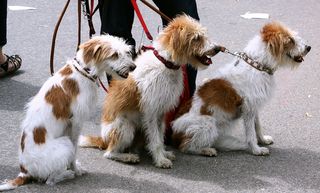
By: Emily D. Levine, DVM, DACVB, MRCVS; Animal Emergency and Referral Associates of New Jersey
Get a dog. Get a leash. The two go hand in hand for most people. Most people think of a leash as something that is needed to walk a dog so the dog doesn’t run away or escape. In other words, they view it as a control device. If a dog is having some behavioral issues, such as not walking nicely on leash or showing aggressive behaviors, some will advise to take this leash and jerk the dog's neck for a "correction." If the dog doesn't respond as the people had hoped, they may be advised to jerk the dog harder and longer. If that doesn't work, perhaps they need to switch collars from a flat collar to a collar with spikes on it (i.e., prong collar) or a small metal collar that can be cinched down to hurt the dog (i.e., choke collar). The worst of the worst will use the leash and collar to lift the dog by his neck up off of the ground to choke the dog to try and correct the dog’s behavior.
Here is where we need a change in perspective.
Get a dog. Get a leash. The two should go hand in hand for people. But, we need to understand that the leash is - and should be - a communication tool, not a corrective tool. We must first find proper leashes, collars, and/or harnesses for each individual dog. Once those have been identified, we need to know: how to safely hold the leash in our hand, when to let the leash loose, when to slide our hand down the leash in a certain way to teach the dog when to slow down, and how the speed of our own footsteps actually are part of the leash/collar/ harness communication. That’s right, how we walk, the speed at which we walk, how we turn with our feet work in tandem with the leash and collar can kindly and humanely teach our dogs how we want them to walk and at which speed we want them to walk. Then, we use cue words to help inform our dogs when we want them to speed up, turn around, or stop/slow down. Any educated trainer will be able to teach and guide you how to communicate with your dog using proper equipment and leash handling skills. This kind of communication helps to build and establish good relationships between dogs and their people, based on trust and clear communication that is not scary.
This goes for EVERY DOG, not just dogs with behavior problems. In fact, proper leash handling and communication can be a preventative for some behavior problems. Proper equipment and leash handling skills should be considered just as basic and necessary as getting vaccines.
* Good rule of thumb: if you have a trainer who is recommending techniques that you would not feel comfortable applying to a child (prong, choke, shock etc…), don't apply them to your dog.
www.Facebook.com/fetchthefacts
petbehaviorblog.com


